Peaches. There is nothing that tastes like summer than biting into a recently picked, perfectly ripe peach that when you bite into it, juice just oozes down your chin and drips down your arm. Pure pleasure.
I am allergic to peaches - they are related to the almond family - so I generally stay away from them. Plus I always thought they weren't that great, a little tasteless and not sweet enough. I thought that I was less allergic when they were a bit hard and under-ripe. However, my interest peaked as everyone at the farmers market started asking about the arrival of the peaches and how they were their favorite part of summer. So when they finally came in season, I couldn't resist to biting into one. Minus the incredibly itchy fuzz which makes me maniacally scratch, they definitely are delicious when juicy and ripe with the juice running down your chin and all over your arms as you try to wipe it off.
Buying: Peaches are either clingstone or free-stone. Clingstone are ones where the flesh is pretty securely attached to the flesh and are usually sent to the canning industry whereas free-stone peaches have pits that hang about the flesh pretty freely. There are a lot of different varieties of peaches and nectarines but realistically, they can be interchangeable. Pay attention to the smell of the fruit as well as the background color. Red, although appealing, doesn't not equate with ripeness or maturity, but with with variety of the fruit. You can tell the type of peach by looking at the ribbed shoulder on the top of the peach - the little strip will be yellow-orange for a yellow fleshed peach and a lighter yellow for a white flesh skin. Look for pieces of fruit that have an orange or golden, not green, hue to their background. Like tomatoes, always trust your nose and smell your fruit - should be peachy keen!
Storing: If you want to keep peaches for longer, keep them in the refrigerator after they have begun to ripen (do not put under-ripe fruit in the fridge as it will dry out the flesh and turn mealy). If you're looking to eat them sooner, leave them out at room temperature. If you want to eat it even sooner, place it in a brown paper bag with a banana (or any fruit that exudes ethylene) and it will expedite the ripening process. They are very fragile and delicate, any damage or bruising will cause them to start decomposing which is why farmers markets may have boxes of "canning" peaches and nectarines. The juices will cause the other fruits to start to rot prematurely as well so they are separated. These are often ready to eat, fallen, bruised, split-pit, even ugly fruits that are perfect for canning, obviously, or making jams, pies, and tarts. Peaches and nectarines, like tomatoes, are climacteric, which means they will continue to ripen after they are picked. So, if you buy a peach or nectarine from the farmers market that is pretty hard, it is because the farmer knows that you might not eat it right away, so leave it on the counter and it will be excellent to eat in a couple days. I'm not quite sure what to answer when people ask me if the fruit will ripen and become softer....what do you think? It will stay hard or just get harder? Of course it will ripen. However, if you go pick your own peaches and nectarines, follow your nose to find the fruit picked off the tree that is just bursting with liquid sugary syrup that will drip down your arm as you take that first bite......

Split Pits
"she obviously has a lot of respect for you. none of our friends know what a split pit is, let alone be able to talk about it for hours."
What's the difference between a peach and a nectarine? Not too much.
Fact: peaches and nectarines are so closely related that sometimes a peach seed will germinate a nectarine tree and a nectarine seed with grow a peach tree! There is just one differentiating gene. Because peaches have hair on their surface - which causes all sorts of uncomfortable itching for me - they are considered to be "pubescent" whereas nectarines have no fuzz, just a smooth surface. Although preferred by some, nectarines are firmer than peaches so they don't have that melt-in-your-mouth effect and therefore don't really fall apart messily all over your hand, half in your mouth like a ripe peach often does.
Medical: Lots of Vitamin A & C and potassium. They are virtually fat-free (less than 1 gram), very low in calories (about 40) and the skin is a good source of fiber!
I AM ITCHINIGLY INCREDIBLY ALLERGIC TO PEACH FUZZ!
....hours of itching at work....
Cooking: When cooking peaches, peel the skin as they will easily peel away throughout the cooking process, however, nectarines do not need to be peeled. To easily peel a peach, put an X with a sharp knife at the bottom of the peach and pop in boiling water to blanch for a couple seconds and then quickly put into a bowl of ice water. The ice water will stop the peach from continuing to cook and the skin will easily peel away. If the fruit is incredibly ripe, blanching is probably not necessary.
If you are using cut fruit, sprinkle some sugar over it to stop it from browning as the exposure to air will cause enzymatic browning.
Recipes:
Peach Bellini
The Bellini is a popular drink in Italy made famous from Harry's Bar in Venice, owned by Giuseppi Cipriani. I always wanted to meet a Giuseppi while I was living in Italy. Anyways, a Bellini is a long drink cocktail served without ice. It is two parts (100mL) prosecco, one part (50mL) white peach puree. The peach puree can be made by blanching a peach to remove the skins, then blending it with a dash of prosecco (a lot of recipes will call for water and lemon juice, but why not prosecco?!). The puree is then added to the glass and topped off with prosecco. A virgin version can be made also by using club soda instead (with the water and lemon juice in the blender).
Tomato Peach and Basil Salad
4 Tomatoes (or to match the amount of peaches, depending on the size)
4 Peaches (2 yellow, 2 white)
Basil
1/4 cup balsamic vinegar
1-2 teaspoons dark brown sugar, optional
2 cloves chopped garlic
salt and freshly ground black pepper
1/2 cup quality extra virgin olive oil
1 teaspoon of Dijon mustard
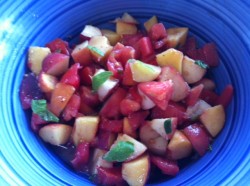
Roughly cut the tomatoes and peaches into bite size pieces. Tear basil into the salad. Whisk together the remaining ingredients to make the vinaigrette. Gently toss and fold into the salad.
Grilled Peach Salad
Dressing:
2 1/2 oz goat cheese, crumbled
Salt and Pepper
5 tablespoons extra virgin olive oil
juice from 1 lemon
1 oz Parmesean, freshly grated
2 large peaches, halved, pits removed
extra virgin olive oil
salt and pepper
2 frisee or endive leaves, washed and dried
small bunch of fresh mint leaves
Put the goat cheese in a pestle and mortar with sea salt and pepper - easy on the salt because the cheese will already be salty. Add the olive oil and lemon juice and mix. Add the parmesean and mix again, but not for too long.
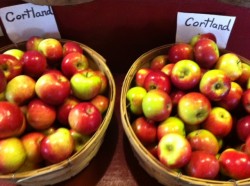
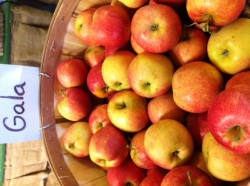
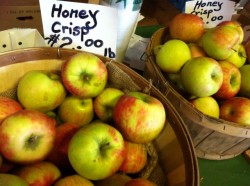
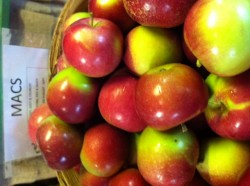
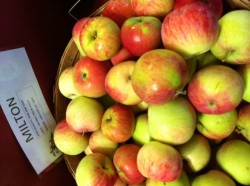
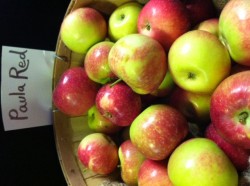
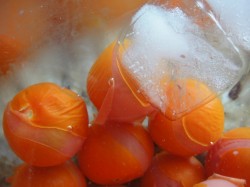
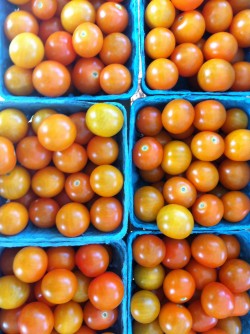




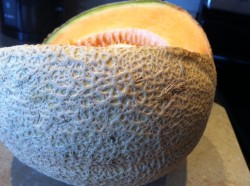
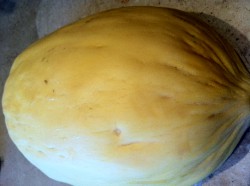
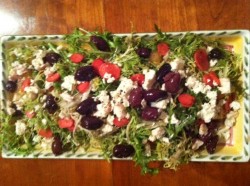
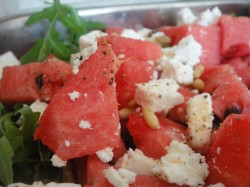 Watermelon, cut into cubes, goes fantastically with some feta cheese, red onion, pine nuts, and fresh basil. Drizzle with some good extra virgin olive oil, a sprinkle of sea salt and a generous amount of freshly ground black pepper.The juicy sweetness of melon pairs incredibly well with salty foods – like feta – so wrapped slices of melon with prosciutto is delicious and easy. Try it grilled!
Watermelon, cut into cubes, goes fantastically with some feta cheese, red onion, pine nuts, and fresh basil. Drizzle with some good extra virgin olive oil, a sprinkle of sea salt and a generous amount of freshly ground black pepper.The juicy sweetness of melon pairs incredibly well with salty foods – like feta – so wrapped slices of melon with prosciutto is delicious and easy. Try it grilled!